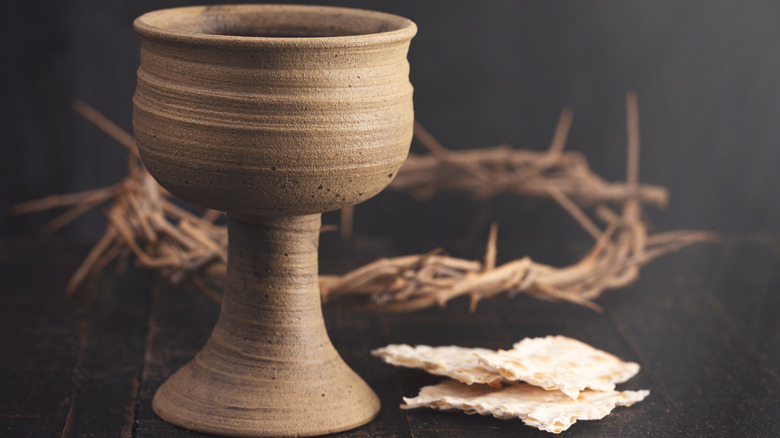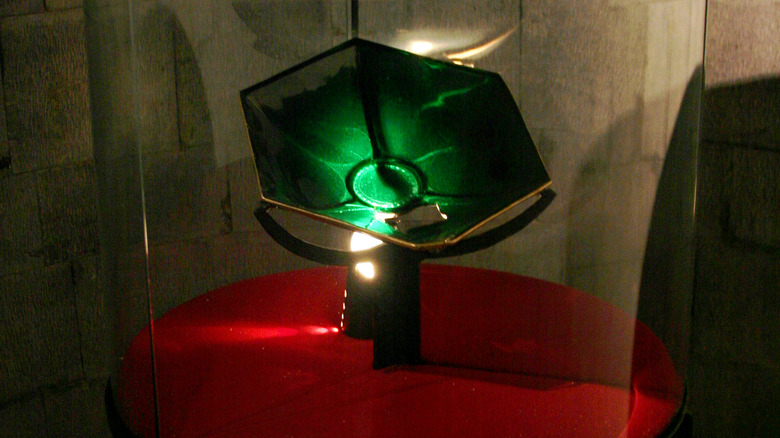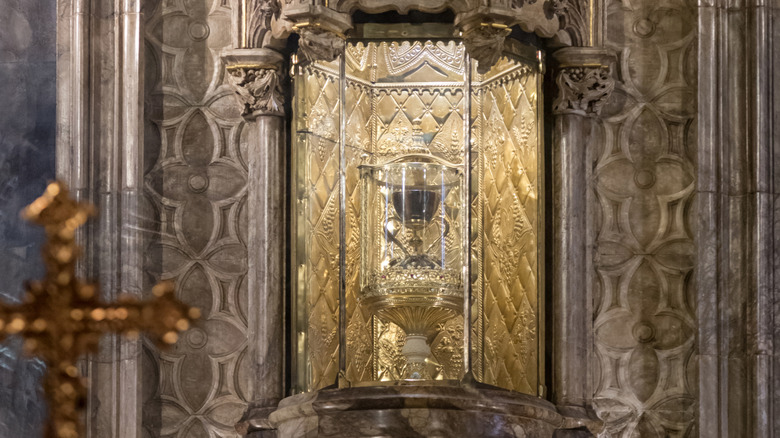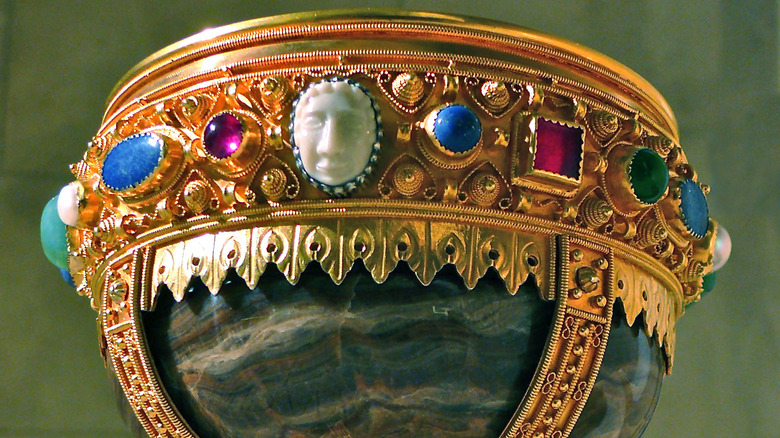The Biggest Theories For What Happened To The Holy Grail
In the unfinished romance "Perceval, the Story of the Grail," the titular knight encounters a gold and bejeweled cup that sustains a holy man for 12 years because it provides him with the consecrated host. In the writings of Robert de Boron, Jesus' cup from the Last Supper is used by Joseph of Arimathea to collect Christ's blood from the cross and is later carried to Avalon. Sir Thomas Malory's "Le Morte d'Arthur" has the Sangreal appear before King Arthur and his knights, later becoming the object of a quest that confirms the nobility and divine grace afforded to Galahad — but also breaks the Arthurian fellowship.
These stories, and others, have all become a part of the legend of the Holy Grail. Various medieval texts built on one another to create that tale, but the fact that the earliest story comes from the Middle Ages should guide any theorizing about the artifact itself. The Bible assigns no significance to the cup Jesus used at the Last Supper, and the closest antecedent to the Holy Grail appears to be a tradition of magical cauldrons and other objects in Celtic and Greco-Roman mythologies. Nevertheless, the Holy Grail took on a profound Christian meaning, elevated the Arthurian romances, and inspired real-life claims of its final residence.
How a mythical object created by medieval authors can have a residence doesn't deter those who seek it. The pull of the Holy Grail has made it very real to many people, who have spun numerous theories as to what happened to it and where it is. Here are a few of them.
An early grail story points to Glastonbury as its resting place
The wedding of the Holy Grail to the legend of King Arthur was a gradual process, but Robert de Boron's work was integral to it. Across three poems, he fleshed out the backstory of the grail as the cup of Christ from the Last Supper. He also gave Merlin magical knowledge of the artifact's history that later informed his efforts in the court of Arthur's father and tied in earlier traditions of Perceval's hunt for the grail with Arthurian lore. And he indirectly inspired a popular candidate for the Holy Grail's residence, assuming it ever existed.
In his first poem, "Joseph d'Arimathie," Boron wrote that Joseph gifted the Holy Grail to his brother Bron, who took it from Israel to the Isle of Avalon. There is some evidence linking stories of Avalon to the real town of Glastonbury, which was once an island in a swamp. Per Hanover College, Giraldus Cambrensis even wrote that "what is now known as Glastonbury used, in ancient times, to be called the Isle of Avalon." And in the 12th century, the monks of Glastonbury Abbey claimed that they had found the tombs of King Arthur and Queen Guinevere there.
Glastonbury's ties to the legend of Arthur inspired some writers to entertain that the Holy Grail is there too. Local tales hold that Joseph himself brought it and set it down, and that spot is now marked by the spring-fed Chalice Well.
The Sacro Catino of Genoa has been called the Holy Grail
In the Treasure Museum of the Cathedral of San Lorenzo in Genoa, Italy, there is a six-sided dish made of green glass on display. Taken from Caesarea in 1101, it's been in the cathedral's hands ever since. It was long believed that the bowl was made of solid emerald, but that assumption was rudely — and literally — shattered when Napoleon asked to borrow it and returned it broken (it's since been repaired, per the Skeptical Inquirer). This is the Sacro Catino, or Holy Basin, and many believe it to be a dish used by Jesus at the Last Supper.
Is it possible it's not just any dish that was used by Jesus, but "the" dish — the Holy Grail? The Sacro Catino has been a popular candidate for the famous relic. Such claims go back to the 16th century, and some Arthurian romances depict the Holy Grail as made of emerald. But besides the fact that the Sacro Catino isn't really made from precious stone, research has concluded that it isn't old enough to be from the time of Jesus. Given limited evidence, it's difficult to determine when and where it was made, but the leading contenders are far from Jerusalem. Still, that hasn't stopped people from continuing to call the Sacro Catino the "Genoese Holy Grail."
[Featured image by José Luiz Bernardes Ribeiro via Wikimedia Commons | Cropped and scaled | CC BY-SA 3.0]
The grail could be on display in Valencia
Quite apart from the Arthurian tradition, there are legends that Saint Peter carried the Holy Grail with him from Jerusalem to Rome. In this tradition, the artifact was used by the popes during the Eucharist until 258 A.D., when it was taken away to avoid the wrath of the Roman emperors. It eventually fell into the hands of the kings of Aragon, who had to part with it in 1437 to clear their debts with the church in Valencia, Spain. The grail became a treasured relic of the cathedral there, and it remains on display to this day.
The grail — or Santo Cáliz — of this story is a real object, an agate cup set in an elaborate and bejeweled handle and base. Studies have dated the relic to anywhere from the 2nd century B.C. to the 1st century A.D., giving it a plausible age for the cup of Christ. It's also probable that the artifact originated in the Middle East, though the handle and base were added much later. But as for the story of the Santo Cáliz traveling from Israel to Spain by way of Rome, there is no hard evidence for it.
There is a letter from 1134 claiming the cup belonged to Jesus, and it does have one detail that matches a piece of grail lore. Per National Geographic, Wolfram von Eschenbach's "Parzival" says that an inscription around the Holy Grail will appear and disappear. On the base of the Santo Cáliz, there is an inscription that disappears when viewed at a certain angle.
Authors have claimed a Spanish chalice is the Holy Grail
Because of how intimately the legend of the Holy Grail is bound to legends of King Arthur, it can feel like a quintessentially English story, despite the central object being a Middle Eastern relic. But Spain has a rich grail tradition of its own. Besides the Santo Cáliz, the Chalice of Doña Urraca has also been identified as the Holy Grail. The chalice is an onyx cup encased in jewel-encrusted gold kept at St. Isidore's Basilica in León. It takes its name from the daughter of King Ferdinand I of León.
In 2014, authors Margarita Torres and José Ortega del Río claimed that the Chalice of Doña Urraca was not just an artifact of local history but the Holy Grail itself. The writers were initially investigating other relics in the basilica when they found documents tracking the chalice's journey from Jerusalem to Cairo to Spain, where it eventually passed from Muslim to Christian hands. Dating on the chalice's onyx puts it between the 2nd century B.C. and the 1st century A.D., just like the Santo Cáliz.
Torres and del Río stopped short of claiming that the chalice was literally the cup used by Jesus at the Last Supper — there's no way to prove that. They are confident, however, that it was venerated as the Holy Grail in early Christian communities.
[Featured image by José-Manuel Benito Álvarez via Wikimedia Commons | Cropped and scaled | CC BY-SA 3.0]
Did the Knights Templar really carry away the Holy Grail?
King Arthur's knights aren't the only ones who've become associated with the Holy Grail. The Knights Templar, originally founded to protect pilgrims journeying to Jerusalem, have obtained legendary status for their military prowess during the Crusades, the eventual persecution and destruction of the order, and the model they provided other chivalric organizations. Mythology has also connected them to quests for the Holy Grail, perhaps as early as Wolfram von Eschenbach's "Parzival," which features a Templar-like order who help the Fisher King guard the relic.
Over time, as literature about the Holy Grail was construed as dealing with a literal object, some writers and conspiracy theorists assumed that the grail was the real raison d'être for the Knights Templar. In this scenario, the order was in Jerusalem to guard the cup of Christ, and they were destroyed because of their involvement with such divine mysteries. And this assumption has driven a number of stories about the final fate of the Holy Grail.
One such story holds that, before their destruction, the Knights Templar brought the Holy Grail to Poland in the 13th century. Facing exile, they put the grail and some gold into a wooden box and sunk it in a lake near Myślibórz. That treasure has never been recovered, and the lake has since dried out. If anything really was left behind by the order, it's either lost for good or long since spirited away.





